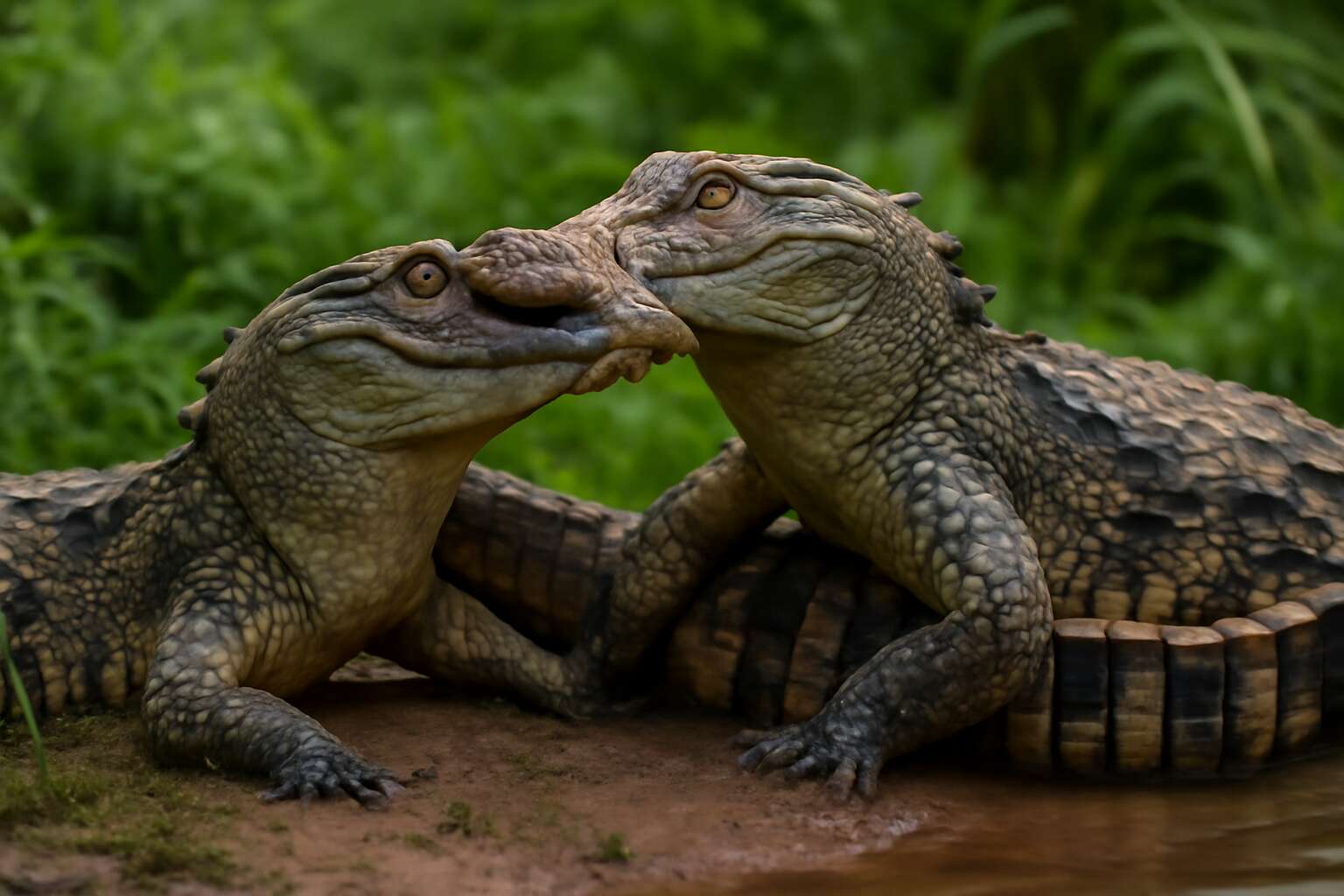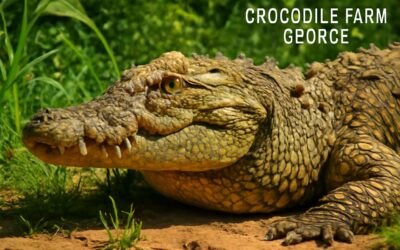Understanding Crocodile Reproductive Behavior
Overview of Crocodile Mating Habits
In the shadowy depths of the reptilian world, understanding how crocodile mate reveals a fascinating interplay of instinct, dominance, and timing. These ancient creatures, remnants of a prehistoric era, engage in a courtship ritual that is as intense as it is cryptic. Unlike many animals that follow predictable patterns, crocodile mating involves a complex dance of vocalisation, territorial displays, and subtle physical cues. Their reproductive behaviour is a testament to survival—each move carefully calculated to secure the future of their lineage.
During the mating season, which typically peaks in warm months, male crocodiles become fiercely territorial, defending prime nesting sites with relentless vigour. Females, selecting their mates based on strength and dominance signals, often choose males that display superior physical condition. Understanding how crocodile mate involves observing their elaborate courtship rituals, which can include head-slapping, vocal calls, and specific postures designed to attract the opposite sex. These behaviours are not random but serve a vital purpose in the reproductive cycle.
- Male crocodiles establish dominance through physical displays and vocalisations.
- Females assess potential mates based on size, strength, and behavioural cues.
- The courtship culminates in the male mounting the female, leading to insemination.
Factors Influencing Crocodile Mating Seasons
Understanding crocodile reproductive behaviour hinges on recognising the environmental factors that influence their mating seasons. Crocodiles are ectothermic creatures, meaning their activity levels and reproductive cycles are heavily dependent on temperature and climate. Warmer months typically trigger the onset of the breeding season, as these conditions optimise the viability of eggs and hatchlings.
Several key factors come into play when considering how crocodile mate. First, temperature fluctuations signal the start of mating activities. Increased daylight hours and rising temperatures stimulate hormonal changes that prompt males to establish territories and engage in courtship rituals. Second, the availability of suitable nesting sites influences the timing and success of breeding. During peak season, males become fiercely territorial, vying for prime locations to attract females.
- Temperature and climate patterns
- Availability of suitable nesting sites
- Water levels and habitat conditions
All these elements intertwine, creating a complex web that determines when and how crocodile mate. Their reproductive cycle is finely tuned to environmental cues, ensuring their survival across millennia. The intricacies of how crocodile mate reveal a remarkable adaptation to their habitat’s rhythms and resources.
Differences Among Crocodile Species
Within the shadowy depths of their aquatic realms, crocodile reproductive behaviour exhibits a fascinating tapestry of adaptations that vary remarkably among species. While the overarching theme of environmental cues remains consistent—temperature, water levels, and habitat availability—each species has carved out its unique reproductive niche. For instance, the saltwater crocodile (Crocodylus porosus) displays a pronounced preference for nesting on coastal beaches, whereas the Nile crocodile (Crocodylus niloticus) often opts for riverbanks and inland waterways. Understanding how crocodile mate involves delving into these nuanced differences, which influence not only the timing of their mating rituals but also their courtship displays and territorial strategies.
In the realm of species-specific reproductive behaviour, some crocodiles engage in elaborate vocalisations and visual displays to attract mates, while others rely heavily on territorial dominance. The intricacies of their reproductive cycles are often dictated by the habitat’s particular environmental pressures. For example, temperature fluctuations play a significant role, but the degree of influence varies—highlighting the complexity behind how crocodile mate across different regions. These variations underscore the importance of recognising that each species has adapted to its unique ecological niche, ensuring their survival through specialised reproductive tactics.
- The Nile crocodile, primarily found in African river systems, tends to have a longer nesting period aligned with seasonal floods, which provide the ideal conditions for hatchling survival.
- The American crocodile (Crocodylus acutus), often dwelling in coastal lagoons, exhibits a more flexible breeding schedule, adjusting to fluctuating water levels and climate variables.
Such distinctions not only deepen our understanding of how crocodile mate but also reveal the remarkable evolutionary resilience of these ancient predators. Each species’ reproductive behaviour embodies a symphony of ecological interactions, where environmental cues orchestrate the intricate dance of courtship, nesting, and ultimately, the continuation of their lineage.
The Mating Rituals of Crocodiles
Courtship Displays and Behaviors
In the shimmering heat of dawn, crocodiles engage in a captivating ballet of courtship displays that embody both primal instinct and intricate communication. These majestic creatures use a combination of vocalisations, body postures, and subtle movements to attract mates, revealing a world rich with silent signals and raw power. Their courtship rituals are a testament to nature’s artistry, where each gesture and sound plays a pivotal role in the delicate dance of reproduction.
Understanding how crocodile mate involves observing their elaborate behaviors, which often include head-slapping, tail waving, and the resonant growls that echo across the riverbanks. During the mating season, males become especially vocal, emitting deep bellows that serve as both a claim to territory and an invitation to females. These signals are crucial for selecting a suitable partner amidst the chaos of their environment.
Among these behaviors, some species exhibit unique displays that enhance their chances of reproductive success. For example, males may engage in physical contests or display vibrant throat pouches as a sign of strength and vitality. Such visual cues are integral, helping females assess the fitness of potential mates, ultimately influencing the complex process of how crocodile mate in their natural habitat.
Vocalizations and Communications
In the shadowed silence of dawn, the symphony of crocodile communication begins—a primal chorus that echoes across the river’s edge. Their vocalisations are not mere sounds but intricate signals that reveal a profound language of love and territorial assertion. During the mating season, males emit resonant bellows, deep and rumbling, serving as both a declaration of dominance and an invitation to receptive females. These powerful calls can travel long distances, acting as beacons in the vast aquatic wilderness, guiding potential mates through the chaos of their environment.
Understanding how crocodile mate involves more than just observing physical attraction; it’s about deciphering this complex auditory tapestry. Some species employ a series of clicks, grunts, or guttural roars that fluctuate in rhythm and intensity, each serving a specific purpose in the courtship ritual. These vocalisations are often complemented by visual cues—such as head-slapping or tail-waving—creating a multi-layered form of communication. The combination of sound and sight ensures that only the most suitable partner is chosen, reinforcing the importance of these signals in the elaborate dance of crocodile reproduction.
Interestingly, the vocalisations of crocodiles are finely tuned to their social and environmental context. For example, during peak breeding times, the sounds become more aggressive and frequent, heightening the stakes of the mating game. As the males compete for dominance, their calls can escalate into a cacophony that resonates through the wetlands—each sound a testament to their vitality and fitness. This auditory display is a vital element in understanding how crocodile mate, showcasing their remarkable ability to communicate with subtlety and strength amid the wild chaos of their habitat.
Male Competition and Territoriality
In the brutal theatre of crocodile reproduction, male competition ignites a primal ballet of strength and strategy. The quest to secure a mate is less a gentle courtship and more a fierce contest for dominance. Males stake their claim through a combination of vocal prowess, physical displays, and territorial fortification, transforming the wetland into a battleground of survival and seduction.
Central to this struggle is the assertion of territoriality, where males fiercely defend prime nesting sites that signal their fitness and resource control. This territorial behaviour is often reinforced by aggressive displays—head-slapping, tail-waving, and intimidating posture—that serve as visual declarations of strength. The dominant males, with their thunderous bellows and assertive presence, essentially broadcast their availability and prowess to interested females, who are discerning in their choice of partner.
During this turbulent period, the hierarchy among males becomes evident. Some species exhibit a clear pecking order, with the strongest males monopolising the best territories and attracting the most receptive females. The competition culminates in an intricate dance of dominance, where only the fittest males successfully mate. This fierce rivalry underscores the importance of understanding how crocodile mate—an elaborate process driven by instinct, strength, and cunning, setting the stage for the next generation of these formidable predators.
The Mating Process in Crocodiles
How Male Crocodiles Find and Court Females
In the shadowy depths of the swamp, where darkness clings to the water like a shroud, the male crocodile’s pursuit of a mate is a ballet of primal intensity. How crocodile mate is a question that echoes through the murky waters, revealing a ritual both ancient and eerily captivating. The male, driven by an instinct as old as time, detects subtle cues from the female — her movements, her vocalisations, the faint ripple of her body beneath the surface. These signals are the keys that unlock the courtship dance.
Once a potential mate is identified, the male croc employs a series of displays to win her favour. These include a combination of territorial posturing and vocal communication, which serve to demonstrate strength and stamina. Sometimes, the male will even engage in vigorous head-slapping or tail-thumping to assert dominance. The process is not merely about attraction — it is a fierce assertion of survival, where only the strongest and most determined male will succeed in the elusive quest of how crocodile mate.
Copulation Mechanics and Duration
The mating process of crocodiles is a captivating spectacle, shrouded in primal rituals that have persisted for millions of years. Once a male crocodile successfully locates a receptive female, the mechanics of copulation unfold with a surprising blend of violence and precision. Typically, the male mounts the female in a process that is both instinctive and highly synchronised, often lasting from 10 to 20 minutes. During this period, the male aligns his cloaca with the female’s, facilitating the transfer of sperm through a specialised organ called the phallus. This organ, unique to crocodilians, acts as the conduit for fertilisation, ensuring the process is efficient even in turbulent waters.
Understanding how crocodile mate involves appreciating the subtle yet powerful signals exchanged during this intimate act. The duration of copulation is crucial, as it maximises the chance of successful fertilisation amidst the chaos of their environment. Interestingly, the entire sequence is often preceded by intense courtship displays, which serve to confirm mutual readiness. The question of how crocodile mate remains a subject of fascination, blending ancient instinct with modern biological adaptations that have allowed these formidable predators to thrive across millennia.
Mate Selection and Reproductive Strategies
The process of how crocodiles mate is a fascinating blend of ancient instinct and strategic behaviour. Unlike many other reptiles, crocodiles employ a complex reproductive strategy that ensures their survival across millions of years. During courtship, males often engage in elaborate displays, such as head slapping and vocalisations, to attract females and establish territorial dominance. These behaviours are crucial in the selection process, as they signal strength and fitness, key factors in how crocodile mate.
Once a female shows receptivity, the actual act of copulation typically involves the male mounting the female in a swift, calculated motion. The transfer of sperm occurs through the crocodile’s specialised organ called the phallus, which is uniquely adapted for efficient fertilisation. The entire process, usually lasting between 10 and 20 minutes, is often preceded by a series of vigorous courtship rituals. These displays serve not only to confirm mutual readiness but also to weed out less fit competitors.
In understanding how crocodile mate, it’s important to note the reproductive strategies that underpin their success. For instance, many species exhibit a form of territoriality that influences mate choice and access. These strategies are finely tuned to their environment, allowing crocodiles to reproduce effectively even in turbulent waters.
- Territorial displays
- Vocal communication
- Physical dominance
Each element plays a vital role in ensuring that only the strongest genes are passed on, securing the persistence of their lineage for generations to come.
Nesting and Fertilization
Oviposition and Nest Construction
When it comes to understanding the fascinating world of how crocodiles mate, little is more intriguing than their nesting and fertilization rituals. After a fiery courtship dance that can last for days, female crocodiles often select a prime spot—usually a sunny, marshy bank—for oviposition. This is where the real magic begins. The female carefully excavates a nest, sometimes a mound of mud and vegetation, turning nature into her personal construction zone.
Once the eggs are laid, fertilization occurs internally, with the male crocodile transferring sperm during copulation. The eggs are then buried deep within the nest, where they incubate in a warm, humid environment. Interestingly, the female’s behaviour during this period is almost maternal—guarding her nesting site fiercely against predators and rival crocs alike. The entire process exemplifies a delicate balance of instinct and environment, all driven by the fundamental question of how crocodile mate and reproduce successfully.
Male’s Role in Nesting
In the grand tapestry of crocodilian reproduction, the role of the male is both regal and strategic, weaving strength and patience into the intricate dance of how crocodile mate. Once the courtship has culminated in mutual interest, the male assumes a pivotal position—guarding his chosen female with a vigilant gaze and subtle displays of dominance. His role extends beyond mere courtship; he actively participates in the nesting process, often competing fiercely with rivals to secure a prime territory for mating. These territories are not just breeding grounds, but arenas where the male’s prowess is tested and validated.
During copulation, which can last for several minutes, the male aligns himself with the female in an elegant, almost ritualistic embrace. After successful fertilization, his role shifts to ensuring the continuation of his genetic legacy. Some males will remain nearby, defending the nesting site from intruders and rival males, thus increasing the chances of reproductive success. It’s a captivating blend of instinct and strategy, illustrating how crocodile mate is a complex behaviour driven by innate survival instincts and environmental cues.
Fertilization Process and Timing
Following fertilization, the next critical phase in the crocodile’s reproductive cycle involves nesting and laying eggs. Once the female has selected a suitable site—often a mound of vegetation, mud, or sand—she begins constructing her nest with remarkable precision. This nesting behaviour is essential, as it provides incubation conditions vital for embryo development. The timing of fertilization plays a pivotal role here; it typically occurs shortly before the female initiates nest building, ensuring that the eggs are fertilized at the optimal moment for incubation.
During the nesting process, the female carefully deposits her clutch of eggs—sometimes numbering in the dozens—into the concealed nest. The temperature within the nest is crucial, influencing the sex of the hatchlings. Warmer conditions tend to produce males, while cooler environments favour females, adding an intriguing layer of environmental influence on how crocodile mate outcomes unfold. After laying, the female covers the eggs, camouflaging the nest from predators and rivals alike, demonstrating her instinctual drive to protect her reproductive investment. The entire cycle, from fertilization to incubation, underscores the delicate interplay of behaviour and environment that characterises how crocodile mate and reproduce successfully.
Crocodile Reproductive Cycles and Care
Timing of Reproductive Cycles
Crocodile reproductive cycles are finely tuned to environmental cues, ensuring that breeding occurs at optimal times for survival. Typically, these cycles are influenced by seasonal variations in temperature and rainfall, which signal to crocodiles when to initiate mating behaviours. Understanding how crocodile mate involves recognising the precise timing of these cycles, which can vary among species but generally align with the wet season. During this period, male crocodiles become more territorial and vocal, vying for the attention of receptive females.
The care timing of reproductive cycles is crucial for the survival of offspring. Crocodiles often lay eggs in nests constructed from vegetation and mud, with females carefully selecting nesting sites that offer protection and suitable microclimates. The fertilisation process is tightly synchronised with oviposition, ensuring that eggs are incubated during the warmest parts of the year—maximising hatchling success. The entire reproductive process showcases nature’s remarkable precision and adaptability, all driven by the instinct of how crocodile mate during these critical periods.
Incubation and Hatchling Development
The reproductive cycle of crocodiles is a masterclass in biological precision, intricately woven into the fabric of their environment. During the warm, wet season, female crocodiles lay their eggs in carefully chosen nests, often made from vegetation and mud, which provide essential microclimates for incubation. This period is not only vital for fertilisation but also for ensuring the survival of hatchlings, as the timing aligns with optimal temperature and humidity levels.
Incubation durations vary among species, typically lasting between 70 to 100 days. Throughout this time, the mother vigilantly guards her nest, demonstrating a remarkable maternal instinct that enhances hatchling success. Once the eggs hatch, tiny crocodile hatchlings emerge, often calling out to their mothers in a high-pitched series of vocalisations. These early moments are critical, as hatchlings must quickly find safety in water, navigating a complex world from the moment they first open their eyes.
Parental Investment and Protection
In the shadowed depths of aquatic realms, the dance of crocodile reproduction unfolds with a fierce, primal elegance. How crocodile mate is a spectacle of instinct, where courtship rituals ignite amidst the murmur of rippling waters. Male crocodiles, driven by a potent mix of territoriality and desire, often engage in vocal displays and aggressive posturing to attract a receptive female. These vocalisations—deep bellows and resonant calls—serve as auditory beacons, guiding potential mates through the labyrinth of their environment.
Once the union is initiated, copulation is a swift yet intricate affair, often lasting just a few minutes but packed with significance. During this fleeting act, the male aligns with the female in a precise, almost ritualistic manner, ensuring successful fertilisation. The reproductive cycle is finely tuned to environmental cues, with males competing fiercely to secure access to the most desirable females. This fierce competition underscores the importance of reproductive success in the survival of each species, weaving a narrative of resilience and dominance in the wild.
Following fertilisation, the female’s role morphs into that of a vigilant guardian. She constructs nests—often from vegetation, mud, and debris—creating a microclimate where her eggs can incubate safely. The care and protection demonstrated by mother crocodiles are remarkable; she guards her nest tirelessly, warding off predators and rivals alike, exemplifying parental investment that significantly boosts hatchling survival. Through this intricate cycle of courtship, copulation, and parental care, the survival of crocodile species is woven into the very fabric of their environment, a testament to nature’s relentless drive for continuity.
Conservation and Impact on Crocodile Reproductive Behavior
Threats to Crocodile Populations
Despite their reputation as ancient predators, crocodiles face significant threats that impact their reproductive success and long-term survival. Habitat destruction, pollution, and illegal poaching have led to declining populations in many regions. These factors not only reduce available nesting sites but also disturb the delicate balance of their reproductive cycles, making it harder for crocodiles to successfully mate and reproduce.
Conservation efforts are crucial in maintaining healthy crocodile populations. Protecting nesting grounds and enforcing laws against illegal hunting can help ensure that crocodiles continue to engage in their natural mating behaviours. Additionally, understanding how crocodile mate is vital for developing effective conservation strategies that support their reproductive health and resilience.
Threats to crocodile populations are multifaceted. Urbanisation encroaches on vital habitats, while climate change alters the timing of breeding seasons and affects hatchling survival rates. A focused approach on safeguarding their environment and addressing these threats can make a difference in preserving these remarkable creatures for future generations.
Protective Measures and Their Effects
In the shadowed realms of ancient waterways, the dance of reproduction remains a vital, yet fragile, ritual. Conservation efforts serve as a beacon of hope, safeguarding the sanctuary where crocodiles engage in their mysterious courtship. Protecting nesting grounds and enforcing laws against illegal poaching are paramount steps in preserving these primordial creatures and understanding how crocodile mate is an intricate puzzle rooted in survival and dominance.
By establishing protected zones, we can minimise the disturbances that threaten their reproductive cycles. Such measures not only uphold the sanctity of their breeding sites but also ensure the delicate balance necessary for successful mating. When these habitats are preserved, the males and females can perform their age-old rituals undisturbed, fostering a resilient population that endures beyond the shadows of extinction.
Furthermore, targeted conservation strategies can influence their reproductive health. A focus on habitat restoration and legal enforcement creates an environment where crocodiles can continue their dark, ancient ballet of courtship and copulation. These protective measures ripple through the ecosystem, reinforcing how crocodile mate and reproductive behaviour are crucial threads woven into the fabric of their survival story.
Research and Conservation Efforts
Conservation efforts have become the lifeblood of crocodile reproductive research, unveiling the mysteries of how crocodile mate in their shadowy habitat. These ancient creatures rely on pristine nesting sites and undisturbed territories, making habitat protection crucial. When these vital areas are safeguarded, scientists can observe authentic mating behaviours, shedding light on the complex dance of courtship and copulation.
Protecting these ecosystems not only preserves the species but also enhances our understanding of their reproductive strategies. Initiatives such as establishing protected zones and enforcing anti-poaching laws directly influence how crocodile mate, ensuring the continuation of their dark, primal rituals. Such measures foster a resilient population, allowing researchers to study their intricate mating behaviours without interference.
Furthermore, conservation strategies impact reproductive health and success. By restoring habitats and reducing human disturbances, we create conditions where crocodiles can perform their ancient courtship displays. This, in turn, helps us decode how crocodile mate and the vital role these behaviours play in the survival of their species. Ultimately, conservation efforts are the key to unlocking the secrets of crocodile reproduction and ensuring these prehistoric predators endure for generations to come.




0 Comments